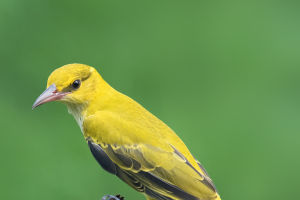Yellow-Throated Bee Tiger
The Yellow-Throated Bee-Eater is a member of the bee-eater family and is known for its beautiful, bright coloration. The entire family is renowned for its vibrancy, with each member boasting a bright body color.
They are mainly distinguished by the color of their throats: yellow-throated bee-eater, blue-throated bee-eater, green-throated bee-eater, chestnut-throated bee-eater, red-throated bee-eater, and white-throated bee-eater, with the yellow-throated bee-eater being the largest of the family.
As its name suggests, the Yellow-Throated Bee-Eater feeds primarily on bees and wasps, which make up about 70% of its diet. Despite the potential threat of being stung, the bee-eater family is fearless in its pursuit of prey.
They use a technique where they repeatedly knock their prey to remove the bee's poisonous stingers before tossing them up and catching them in their mouths. With their sharp vision, they can spot insects up to 50 meters away and can catch more than a hundred insects per day.
While the Yellow-Throated Bee-Eater appears monogamous, their social relationships are chaotic. None of them is faithful, and despite appearing to be in love, they are deceitful and seemingly incompatible.
Males occasionally mate with other females, and females sometimes lay their eggs in the nests of other females, similar to cuckoos. However, if the young are born, the male usually takes on the responsibility of feeding them.
Despite its beautiful appearance, the Yellow-Throated Bee-Eater is not particularly hygienic. They do not clean their nests, allowing leftover food and chick excrement to accumulate, making their living quarters unsanitary. Therefore, they must expose themselves to the sun to clean parasites out of their feathers.
The Yellow-Throated Bee-Eater is found in most parts of the world, with a population of about 11 million individuals. Currently, it is not considered threatened. Its beauty makes it popular with many birdwatchers. However, it is essential to remember that while nature is stunning, it is also real.
The Yellow-Throated Bee-Eater is a medium-sized bird of the bee-eater family. It measures 23-30 cm in length and has a narrow black chest band under its yellow throat and a blue-green lower body.
The forehead is blue-white, with a wide black pattern through the eye. The top of the head to the back of the neck is dark chestnut, and the tail is blue-green, with the central tail feathers extending conspicuously from the other tail feathers.
This bird is a summer migratory species that arrive in Xinjiang in April in the spring and departs in September and October in the autumn. They often move in flocks, flying most of the time during the day and perching on wires, dead branches, or shrubs when resting.
Birds are our friends and nature's elves. Their existence adds beauty to nature and serves as a barometer of the ecological environment. The Yellow-Throated Bee-Eater is a stunning gift of nature, and observing these natural performers in action is a pure delight that can make one forget all their worries and tiredness.
The yellow-throated bee tiger is a fascinating bird with a unique diet and colorful appearance. Its ability to catch and eat bees and wasps without fear of being stung is impressive, and its keen vision allows it to spot prey from far distances.
Despite its monogamous relationship, the yellow-throated bee tiger has a somewhat chaotic social structure, with occasional mating and egg-laying outside of its established pair bond. However, the species is non-threatened and has a healthy population size of around 11 million individuals.


